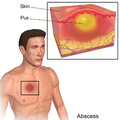Abscess facts for kids
Quick facts for kids Abscess |
|
|---|---|
| Synonyms | Latin: Abscessus |
 |
|
| Five-day-old inflamed epidermal inclusion cyst. The black spot is a keratin plug which connects with the underlying cyst. | |
| Symptoms | Redness, pain, swelling |
| Usual onset | Rapid |
| Causes | Bacteria (often MRSA) |
| Diagnostic method | Ultrasound, CT scan |
| Similar conditions | Cellulitis, sebaceous cyst, necrotising fasciitis |
| Treatment | Cutting it open |
| Frequency | ~1% per year (United States) |
An abscess is like a pocket of pus that forms inside your body's tissues. You might notice an abscess because it looks red, feels warm, hurts, and is swollen. If you gently press on the swelling, it might feel like it's filled with liquid. The red area often spreads out from the main swelling. Things like boils and Carbuncles are types of abscesses. They often start around hair follicles, with carbuncles being bigger than boils.
Abscesses are usually caused by a bacterial infection. Often, many different kinds of bacteria are involved in one infection. In the United States and many other places, the most common bacteria found is methicillin-resistant Staphylococcus aureus. Very rarely, parasites can cause abscesses. This is more common in developing countries.
Doctors usually diagnose a skin abscess by looking at it. They confirm it by cutting it open. An Ultrasound scan can be helpful if it's not clear what the problem is.
The main treatment for most skin or soft tissue abscesses is to cut them open and let the pus drain out. Using antibiotics along with this treatment seems to help. There's some evidence that it's better not to pack the empty space with gauze after draining.
Closing the empty space right after draining, instead of leaving it open, might help it heal faster. It also doesn't seem to increase the chance of the abscess coming back.
Skin abscesses are common and have become more frequent in recent years. In 2005, about 3.2 million people in the United States went to the emergency room for an abscess. In Australia, around 13,000 people were hospitalized with this condition in 2008.
What Are the Signs of an Abscess?
Abscesses can form in any part of your body. However, they are most often found on the skin. On the skin, they can be small bumps (like boils) or deeper skin infections. They can also appear in your lungs, brain, teeth, kidneys, and tonsils.
How to Spot an Internal Abscess
An abscess inside your body is harder to notice. Signs might include pain in that area, a high temperature (fever), and generally feeling unwell. Internal abscesses rarely get better on their own. So, if you think you might have one, it's important to get medical help quickly. Depending on where it is, an abscess can sometimes be very serious.
Images for kids
See also
 In Spanish: Absceso para niños
In Spanish: Absceso para niños


